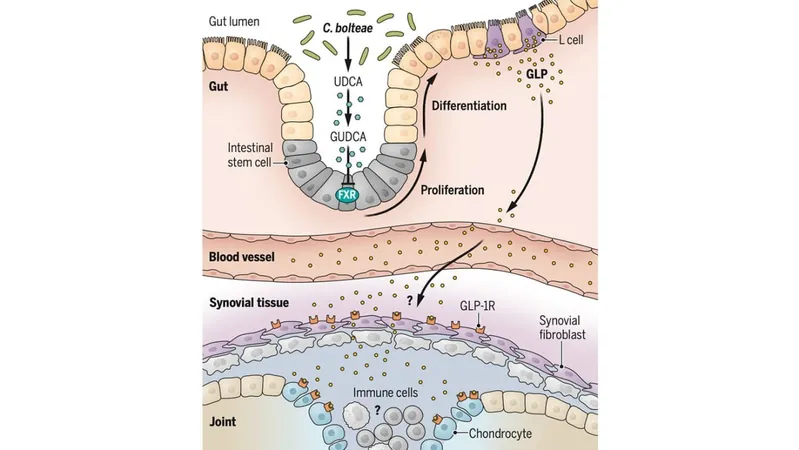
Unlocking Osteoarthritis: How Gut Health Could Transform Treatment
2025-04-16
Author: Wei
A Paradigm Shift in Osteoarthritis Research
Osteoarthritis (OA) affects millions in the U.S., traditionally seen as a wear-and-tear condition. However, groundbreaking research is shifting this narrative, revealing the significant role of metabolic pathways in OA's development and progression.
New Findings from Recent Studies
Recent research published in the journal *Science* has uncovered an intriguing connection between gut health and joint issues, specifically focusing on bile acid metabolism and glucagon-like peptide 1 (GLP-1) signaling. This pivotal study not only advances our understanding of OA but also paves the way for innovative treatment strategies, especially with contributions from experts at Yale.
Expert Insights into OA Mechanisms
Chuan-Ju Liu, Ph.D., a renowned figure in orthopedic research and principal investigator at Yale's Liu Lab, emphasizes the revelation brought forth by this new study. "It transforms the understanding of osteoarthritis from just mechanical damage to incorporating metabolic processes that could revolutionize our approach to treatment," Liu explains.
Bile Acids and Joint Health: What You Need to Know
The research highlights the importance of glycoursodeoxycholic acid (GUDCA), suggesting that a reduction in GUDCA can accelerate OA's progression. In contrast, GUDCA supplementation appears to have protective effects by inhibiting the intestinal farnesoid X receptor (FXR), a vital player in regulating bile acid synthesis and metabolism.
The Gut Microbiome's Surprising Role
Interestingly, Clostridium bolteae, a bacterium within the gut microbiome, was shown to disrupt bile acid balance and influence GLP-1 secretion. Liu states, "This intricate relationship between the gut microbiome and joint health could be key in developing new therapeutic approaches for OA."
Exciting Therapeutics on the Horizon
One promising avenue is ursodeoxycholic acid (UDCA), currently used for liver disorders. This drug has demonstrated potential in restoring bile acid composition and reducing inflammation in OA, indicating a feasible treatment pathway. Additionally, GLP-1 receptor agonists like semaglutide and liraglutide, commonly utilized for diabetes, show potential in alleviating OA symptoms.
Future Research Directions
While early studies are promising, further research is necessary to assess UDCA's long-term safety and efficacy in OA patients. Key questions about dosage, treatment duration, and individual responses based on gut microbiome variations need thorough exploration. Liu urges, "Future studies should prioritize longitudinal clinical trials and detailed metabolomic profiling to refine treatment options for patients."
A Broader Impact: The Gut-Joint Connection
Emerging insights into the gut-joint axis not only challenge the traditional view of OA but also hint at implications for other joint disorders like rheumatoid arthritis. Liu concludes, "Exploring the relationships between gut microbiota, bile acids, and immune responses could unveil new therapeutic targets across a spectrum of musculoskeletal diseases."
As research progresses, this new perspective on osteoarthritis may lead to breakthrough treatments that improve the quality of life for countless individuals.


 Brasil (PT)
Brasil (PT)
 Canada (EN)
Canada (EN)
 Chile (ES)
Chile (ES)
 Česko (CS)
Česko (CS)
 대한민국 (KO)
대한민국 (KO)
 España (ES)
España (ES)
 France (FR)
France (FR)
 Hong Kong (EN)
Hong Kong (EN)
 Italia (IT)
Italia (IT)
 日本 (JA)
日本 (JA)
 Magyarország (HU)
Magyarország (HU)
 Norge (NO)
Norge (NO)
 Polska (PL)
Polska (PL)
 Schweiz (DE)
Schweiz (DE)
 Singapore (EN)
Singapore (EN)
 Sverige (SV)
Sverige (SV)
 Suomi (FI)
Suomi (FI)
 Türkiye (TR)
Türkiye (TR)
 الإمارات العربية المتحدة (AR)
الإمارات العربية المتحدة (AR)